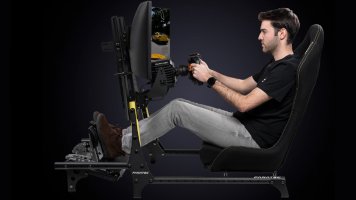Mr Latte
Premium
Your massive contributions to tactile tech surely belie that.
Thanks for being the first (so far as I know) to sample this version 0.1 attempt.
Those are about as different from the 4 Dayton pucks in my ShakeSeat as imaginable.
Indeed, tactile is currently being used only for this plus off-idle and near-redline engine RPM.
I am still sorting measurements by piezo contact elements before deploying a Thruster for braking tactile feedback. All other non-visual feedback currently is by harness tensioning and AccuForce.
I have yet to dismantle my ShakeSeat to evaluate Dayton pucks, but measurements to date suggest
their Thruster is capable of neither responding below 10Hz nor sensed below 25Hz at best;
can no more imagine 3Hz tactile than a blind person can colors.
Practically, I was generally unable to control real cars with tire judder below 40Hz or so.
Thanks for the offer.
Based on what I have read, my HP Reverb would be unhappy with ACC's VR on my current PC.
Hardware upgrade prices should become less unreasonable when/if supply chains recover from lunar new year (May?). I dread feeling like a fish out of water, trying to cope with GT3 car demands...
It has been years since my reflexes could keep up with more than mildly modified street cars.
I dont have exciters up and running at the moment, so what I wanted to do was see primarily how your effects operated/responded. Ive spent a good couple of hours faffing about and well impressed with how these can be implemented for whatever transducer/exciter is being used.
Sorting the Hz that feel good on different units isnt that hard but Ive been keen to get a lovely floaty weight sensation and its really nice around the 2-4Hz on the bigger LFE.
I noticed:
Even with all wheels placed to ouput as mono on a single unit the response is still good.
I will have to look in more depth with spectral analysis but one of the effects seemed to be doing the opposite for L/R
I mean increasing the Hz Vs Decreasing the Hz for the two values used.
Will give a deeper overview at a later time when I have looked more into these but I think this while needing some tweeks could be one of the best custom effects I have tried in a while.
Excellent work
Last edited:










